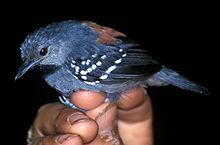Epinecrophylla ornata
| Ornate antwren | |
|---|---|
 |
|
| Male from Cordillera del Cóndor, Ecuador | |
| Scientific classification | |
| Kingdom: | Animalia |
| Phylum: | Chordata |
| Class: | Aves |
| Order: | Passeriformes |
| Family: | Thamnophilidae |
| Genus: | Epinecrophylla |
| Species: | E. ornata |
| Binomial name | |
|
Epinecrophylla ornata (Sclater, 1853) |
|
| Subspecies | |
|
See text |
|
See text
The ornate antwren (Epinecrophylla ornata) is a species of bird in the family Thamnophilidae. It was formerly placed in the genus Myrmotherula but the new genus Epinecrophylla was created in 2006. It is found in Bolivia, Brazil, Colombia, Ecuador, and Peru. Its natural habitats are subtropical or tropical moist lowland forests and subtropical or tropical swamps.
The ornate antwren grows to a length of between 10 and 11 cm (3.9 and 4.3 in). The male has a grey head, neck and underparts, a black throat, a blackish tail and wings (with white tipped wing coverts), and a rufous back and rump throughout most of the bird's range; southern subspecies in Peru have a grey or greyish-brown back and rump. The female is similar but has a black and white speckled throat and buff underparts. The song is a high-pitched series of whistles, descending and getting faster.
The ornate antwren is native to Colombia, Ecuador, Peru, Bolivia and Brazil, being found at altitudes of up to 1,500 m (5,000 ft) in moist forests.
Five subspecies are recognized:
Members of the genus Epinecrophylla tend to be specialists in extracting insects and spiders from clusters of dead leaves using beak and feet, foraging in this way for more than 75% of the time. Another characteristic of the genus seems to be the dome-shaped nest with side or oblique entrance; three of the species have this characteristic, while the nesting behaviours of the other members of the genus are not known.
The ornate antwren is said to be fairly common and has a very wide range, extending to over 2,000,000 km2 (770,000 sq mi). Although the total population has not been estimated, the population trend is thought to be steady in the absence of any indications to the contrary. The International Union for Conservation of Nature has assessed the conservation status of this bird as being of "least concern".
...
Wikipedia

